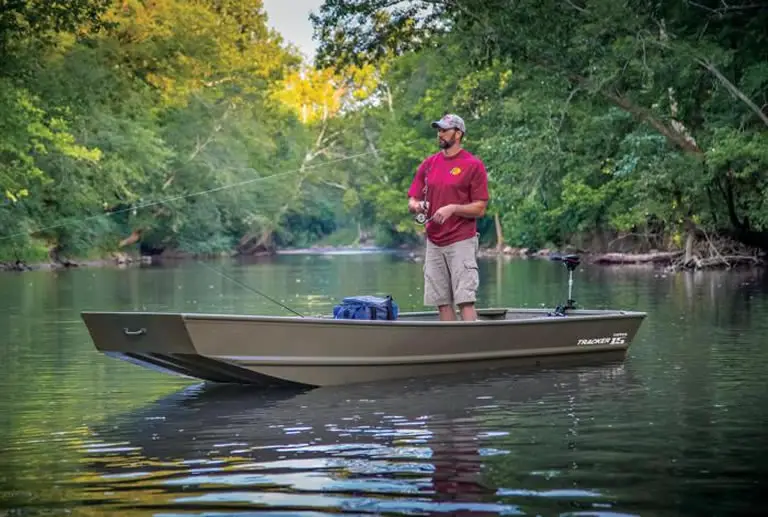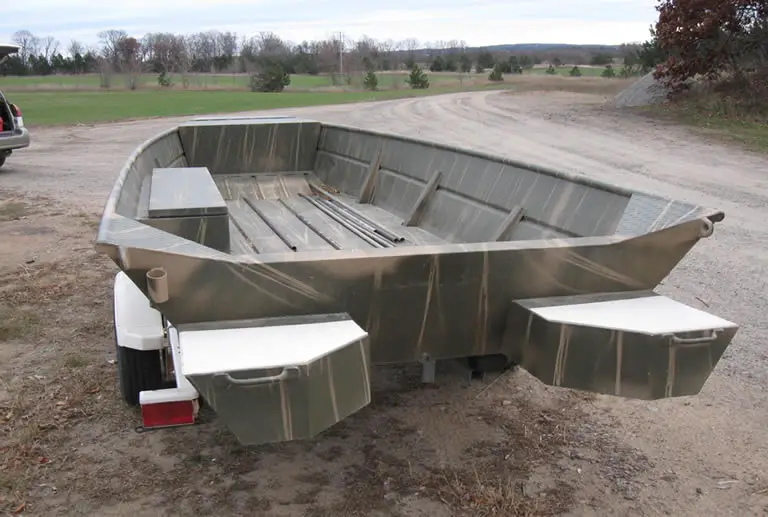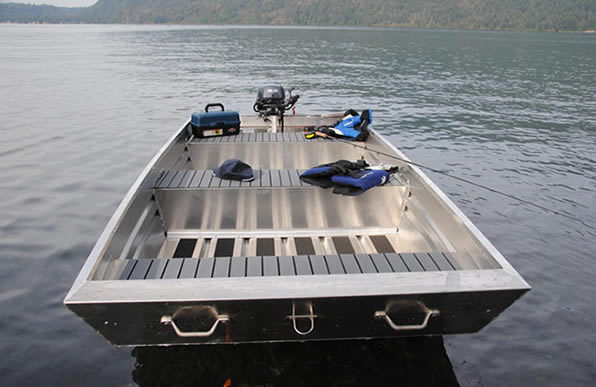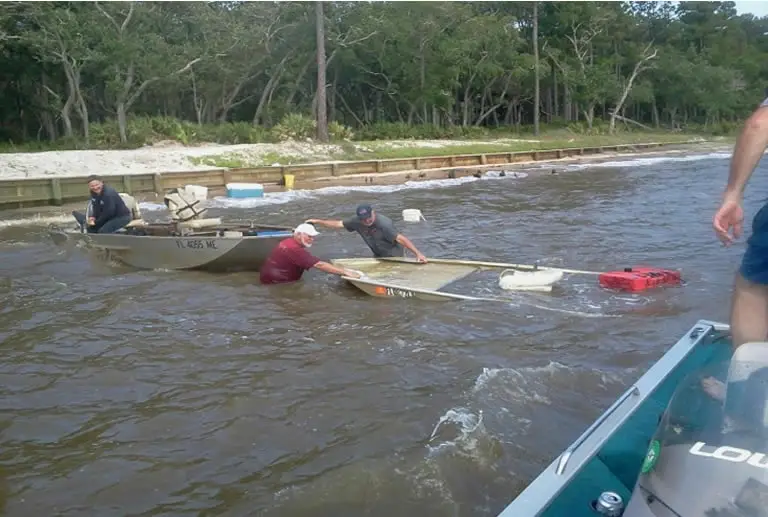Jon boats are calm water, flat bottoms vessels that made from lightweight material. These boats are popular because they are easy to transport and inexpensive. Most Jon boats are made from aluminum but there are also manufacturers that use roto-modelled polyethylene and fiberglass. Due to the lightweight material and hull design of the boat many people are concerned with the safety of using Jon boats.
Contents
Jon Boat Safety
Are Jon Boats safe?
The answer is yes, Jon boats safe but there are a few conditions that should be observed when using one.
Jon boats are flat-bottomed, shallow draft vessels designed to be used on calm waters. Water and weather conditions can affect the stability of a Jon boat.
Fine weather conditions and calm bodies of water are ideal for using a Jon boat.
Using a Jon boat in very rough water and the ocean is not safe.
Design factors that affect the stability of Jon boats
The main thing that makes a Jon boat safe or unsafe is its stability.
There are several factors that affect the stability of a Jon boat.
These are:
- Flat bottom hulls of Jon boats.
- Size and capacity of the boat.
- Difference in bow types.
Flat bottom hulls and safety
The design of a Jon boat, with its flat bottom hull, allows the boat to traverse through very shallow bodies of water, A Jon boat can be used to navigate extremely shallow waters due to its shallow draft.
Unlike other types of boats that have different type of bottoms, like a v-hull, a Jon boat can be used in waters that are only a few inches deep.
The flat shape of the boat’s hull gives the Jon boat a very shallow draft but this capacity for shallow water use also comes at price.
A Jon boat’s shallow draft means that it is ideally designed for use in calm waters.
A Jon boat is one of the safest vessels you could be on in calm water.
On calm water a Jon boat is arguably the most stable boat you could use because it “sits on” the water rather than “in it”.
However, the flat bottom of a Jon boat that offers such amazing stability on calm water has the opposite effect in rough or choppy water.
To understand why this is the case let’s look at boats that are designed for rough water use.
Boats that have a v-shaped bottom, or v-hull, fare better in more turbulent waters because the shape of the hull gives the boat the ability to tilt or wobble in the water because it sits deep in the water.
This in turn gives the boat more stability.

A Jon boat, on the other hand, sits just a few inches in the water and therefore does not have the same “wobble room”.
With its low freeboard a Jon boat can easily start to take on water if it is rocked about on waves.
A Jon boat is not safe to use in very rough water.
The shallow draft and flat bottom of a Jon boat doesn’t give it much stability in rough waters.
Size and capacity of the boat
Another factor that would come to play with the stability of Jon boats, and thus their safety, is the size of the Jon boat that you are using.
Usually larger and wider Jon boats tend to have better stability compared to ones that are smaller and narrower in size.
The longer the Jon boat and the wider its beam the more stable it will be in choppy water.
The smallest Jon boat available is around 10 to 12 feet and due to this small build, the stability of the boat is quite compromised when the water gets a little challenging.
Overloading a Jon boat will create serious safety concerns.
With all boats, but especially those with a low freeboard (where the top of the sides are very close to the water surface) are especially susceptible to becoming unstable and taking on water if they go over their weight capacity.
For the weight capacity of Jon boats read this article.
2 different hull types
As we have seen Jon boats are not designed to be used in rough waters.
Jon boats are designed to be used in calm inland waters.
However, inland waters are not always calm!
So, it should come as no surprise that modern innovations were used to create a second type of Jon boat that is safer to use in rough waters.
Let’s look at these two types of Jon boats to see how they relate to safety and the type of marine environments in which they can be used.
Flat bottom Jon boat design
Jon boats are not designed for ocean use.
Typically, boats designed for oceans or rough waters have bows that are shaped specifically to be able to cut through these rough waves.
Those boats have a “V” shaped bottom to give them more stability in choppy water and waves.
The bow type for vessels that are designed to navigate choppy waters also greatly differ from the design on a Jon boat.

The most common bow types on ocean-faring boats are straight bows, conventional clipper bows, high cain spoon bows, and reverse sheers.
They work by pushing the wave away and towards the sides of the boat creating something called a ‘bow-wave’.
Jon boats, however, do not have this kind of bow.
The usual shape of a Jon boat bow is boxed or square.
This means the boat it unable to push waves away and outwards towards the sides of the boat like an ocean-going vessel does.
This bow type, although great for calm water, results in splashing and a generally wet ride when traversing through waves.
Likewise , when it comes to the hull of a Jon boat the flat bottom may give it superior stability on calm water but it gives it no stability in rough water.
In fact, in rough water it can be downright dangerous to be on a Jon boat.
As we outlined before a standard Jon boat is not designed to be used in rough water.
So what are the modern innovations that were introduced to help combat these rough water problems?
Enter the mod-v Jon boat.
Modified-v Jon boat hull design
A mod-v, also known as a semi-v, Jon boat was designed to allow inland waterway boaters who need the shallow draft and flat bottom design of a Jon but who also regularly have to tackle rough water.
The semi-v type of modification is exactly what it sounds like it is; a Jon boat is given a small amount of “V” shape in its hull – not enough to completely eliminate its shallow daft but just enough to give the boat better stability in more challenging waters.
Mod-v Jon boats can navigate through rough waters better than those with completely flat bottom hulls due to higher sides, more pointed bow and the shape of the hull which gives the boat the ability to be able to lean more when going through waves.
It would be advisable to get this modification if you plan on using your Jon boat regularly on more challenging waters.
A mod-v Jon boat has a more pointed bow to help it cut through choppy water and has a slightly curved bottom, instead of the completely flat bottom of a normal Jon.
This makes it much safer to use in rough water.
This additional safety in rough waters comes at the price of less stability in calm water (though its still pretty stable) and a deeper draft.
A flat bottom Jon can access much shallower waters than a semi-v Jon.
Jon boat safety issues in oceans
Does this mean that Jon boats cannot be used in deeper bodies of water like oceans?
Well, yes and no!
It is possible to be able to fare safely on oceans if you follow the necessary precautions before taking your Jon boat onto the water.
If you don’t take these precautions then the tendency will be for your Jon boat to take on water and eventually sink because of ocean waves.
Jon boats are only safe to use in the ocean under very specific conditions and you must take some careful precautions before venturing out onto the water and while you are on the water.
We have written an extensive guide for using a Jon boat in the sea which you can read here.
Steps to make a Jon boat safer
Below are some simple steps and precautions you can take to make your time on a Jon boat much safer.
Adding extra buoyancy
There are two reasons to add buoyancy to a Jon boat:
- To increase the boat’s stability.
- To help the boat float close to the water surface if it sinks.
You can achieve extra stability on a Jon boat by adding flotation pods or outrigging.
Flotation pods are usually installed at the stern of the boat.

The reason for this is because the stern area is usually the heaviest part of the boat with the gas tank, battery, motor and motor operator all situated there.
You can fix this uneven weight distribution to some extent by moving things like the battery to different parts of the boat. Flotation pods are by far the most efficient and quickest way to solve this problem though.
Outrigging is another way to greatly increase the stability of a Jon boat to make it safer to use in rough water.
Outrigging can take the form of PVC pipes attached to either side of the boat.
You have to make sure that the ends of the pipe should be capped or closed otherwise your time and effort of installing the PVC pipes would all be wasted.
We have covered how to make a Jon boat more stable in this article which includes adding flotation pods and outrigging.
Although foam insulation wouldn’t be that much help when it comes to keeping your boat afloat it is still a good idea to ad some for safety reasons.
Adding foam to your Jon boat will not make it more buoyant on the water but it will make it more buoyant if it goes under the water.
Should a Jon boat that is fitted with onboard foam sink it will float close to the surface of the water.
This not only makes retrieval of the boat much easier but it also means you are less likely to lose expensive equipment onboard but much more importantly anyone in the water can hold onto it to help stay afloat until help arrives.
Precautions to take to stay safe on a Jon boat
Below are some precautions you can take before taking to the water on your Jon boat.
Check the weather
As mentioned before, the weather is a huge factor when it comes to the stability and safe use of Jon boats.
This is especially true when you plan on using it in the ocean. This is because the weather determines how rough the waters will be.
Jon boats are designed for use in fair weather and calm waters.
Though rain is not a problem wind certainly is.
So, if the weather forecast calls for windy weather it would be best if you postponed taking your Jon boat out in the ocean.
As most inland waterways are protected from strong winds the water should still remain sufficiently calm for a Jon boat.
If the area you plan to boat in regularly experiences choppy water then a semi-v (nod-v) Jon boat the best choice.
If boating in open water stay close to shore
As stated before, Jon boats are not designed for rough waters and turbulent waves.
So, if you plan on going to the ocean with your boat, you have to be wary on how much distance you are going to put between you and the shore.
Ocean water can change dramatically and fast!
Never let the shoreline drop below your line of sight.
Adding width to your Jon boat
If you really want your Jon boat to perform better in rough, choppy waters then you should consider having it modified.
Other than adding the pods to improve the buoyancy of the boat, you can also stabilize and make your boat safer by adding width to your boat.

Below are the optimal proportions for your Jon boats:
- 48-inch beam for a 10 ft boat
- 48-inch to 60-inch beam for a 12 ft boat
- 57-inch to 70-inch beam for a 14 ft boat
- 75-inch beam for an 18 ft boat
You can also modify the bottom to give it a more “v” shape and shape the bow to better cut through waves.
Although these are all viable options, the cheap price and ease of availability of used Jon boats means it would probably be better to simply sell your existing boat and buy a wider one.
Just be sure to do your due diligence and follow the advice we give in our Jon boat buyer’s guide.
If you are completely new to the many advantages of using a Jon boat then be sure to also check our our beginner’s guide to buying a Jon boat.
Summary: Are Jon boats safe or not
Overall, Jon boats are very safe vessels when used the way they were designed to be used.
Jon boats are designed to be used in calm, shallow inland waters like rivers and creeks but also excel when used in deep calm water like lakes and ponds.
Although Jon boats are capable of traversing waters only a few inches deep they are just as stable and safe on very deep water as long as it is relatively calm.
However, should you consider using them in rougher, more turbulent bodies of water then these boats would be more dangerous to use.
A standard flat bottom Jon boat is not suitable fro rough water. A semi-v, or mod-v, Jon boat is much better for rough water though neither boat type is safe for ocean use except in very fine calm weather.
You take steps to help stabilize a Jon boat to make it safer to use but if you intend to use the boat only on inland waterways most of these modifications are unnecessary.

